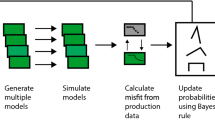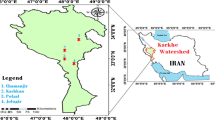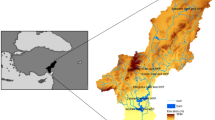Abstract
The reliability of a hydrological model (HydroM) highly depends on how well the model parameters are estimated through the history matching (HisM) process. Direct HisM (DHisM) that calibrates input parameters by iteratively executing a HydroM is widely applied in water resource estimation. The computational time of DHisM is prohibitive, as a single run of the HydroM may take several hours. In practice, calibration accuracy is compromised to arrive at a solution. Therefore, it is desirable to develop a proxy model that can replace HydroM in the HisM process. In this study, we propose a two-stage HisM, wherein we first develop a proxy model for HydroM using artificial neural network techniques. Next we apply ant colony optimisation (ACOR) and robust parameter estimation (ROPE) methods for calibrating the parameter of HydroM. This methodology is illustrated for the Dandalups catchment of Western Australia to calibrate the five global parameters of Land Use Change Incorporated Catchment (LUCICAT) by matching 33 annual daily streamflow peaks. The results reveal that replacing the LUCICAT by proxy model reduces the computational time by more than 90% with similar accuracy to DHisM and shows higher consistency (via standard deviation of RMSE) and reduction of parameter uncertainty.
Access this chapter
Tax calculation will be finalised at checkout
Purchases are for personal use only
Similar content being viewed by others
References
K. Ananda Babu, R.K. Shrivastav, Developing objective function by ant colony optimization for continuous domains (ACOR): sondur reservoir. Int. J. Latest Trends Eng. Technol. (IJLTET) 2, 58–64 (2013)
A. Bardossy, S.K. Singh, Robust estimation of HydroM parameters. Hydrol. Earth Syst. Sci. 12, 1273–1283 (2008)
M.A. Bari, A distributed conceptual model for stream salinity generation processes: a systematic data based approach. Doctor of Philosophy thesis, The University of Western Australia (2005)
Y. Cui, Z. Yi, J. Duan, D. Shi, Z. Wang, A Rprop-Neural-Network-Based PV Maximum power point algorithm with short-circuit current limitation, in Electrical Engineering and System Science. IEEE ISGT NA (2019)
Department of Water: LUCICAT user manual (2012)
Q. Duan, S. Sorooshian, V. Gupta, Effective and efficient global optimization for conceptual rainfall-runoff models. Water Resour. Res. 28(4), 1015–1031 (1992)
P.O. Fernandez, J.P. Teixeira, J. Ferreira, S. Azevedo, Training neural network by resilient backpropagation algorithm for tourism forecasting. Manag Intell. Syst. 41–46 (2013)
S. Fritsch, F. Guenther, M.N. Wright, M. Suling, S.M. Mueller, Package ‘neuralnet’ version 1.44.2 (2019)
U. Groemping, DoE.wrapper: wrapper package for design of experiments functionality, r package version 0.31. https://cran.r-project.org/web/packages/DoE.base/index.html. Accessed 1 Nov 2017
Y. Hajizadeh, M. Christie, V. Demyanov, Ant colony optimization for history matching and uncertainty quantification of reservoir models. J. Petrol. Sci. Eng. 77, 78–92 (2011)
L.R. Joyce, The hydrological impacts of climate change and variability in the Murray Hotham catchment, Western Australia. Honours Dissertation, School of Environment Systems Engineering, The University of Western Australia (2007)
T. Krausse, J. Cullmann, Toward a more representative parameterization of hydrologic models via synthesizing the strength of particle swarm optimization and robust parameter estimation. Hydrol. Earth Sci. 16, 603–629 (2012)
H. Kuntsmann, A. Heckl, A. Rimmer, Physically based distributed HydroMling of the upper Jordan catchment and investigation of effective model equation. Adv. Geosci. 9, 123–130 (2006)
M. Miller, Rprop-description and implementation details. Technical Report. Institut fur Logic, Komplexitat und Dedutionsysteme, University of Karlsruhe (1994)
M. Owen, The Dandalups Catchment scale 1:250,000. Department of Water, Western Australia
F. Simsek, F. Mergen, Optimization of induction motors using continuous ant colony systems. Int. J. Recent Trends Eng. Technol. 4(3), 62–65 (2010)
S.K. Singh, A. Bardossy, HydroM calibration by sequential replacement of weak parameter sets using depth function. Hydrology 2(2), 69–92 (2015)
K. Socha, M. Dorigo, Ant colony optimization for continuous domains. Eur. J. Oper. Res. 185, 1155–1173 (2008)
D. Tjia, R. Gupta, M. Alam, Ants do history matching in hydrology, in Ozwater 2015, Adelaide, South Australia, 12–14 May 2015
D. Tjia, Statistical methods for history matching of HydroM. Doctor of Philosophy thesis, Curtin University, Perth, Western Australia (2016)
D. Tumac, Artificial neural network application to predict the sawability performance of large diameter circular saws. Measurement 80, 12–20 (2016)
A.G.R. Vaz, B. Elsinga, W.G.J.H.M. van Sark, M.C. Brito, An artificial neural network to assess the impact of neighbouring photovoltaic systems in power forecasting in utrect, The Netherlands. Renew Energy 85, 631–641 (2016)
Q.J. Wang, The genetic algorithm and its application to calibrating conceptual rainfall-runoff models. Water Resour. Res. 27(9), 2467–2471 (1991)
Y. Wang, J. Li, J. Gu, Z. Zhou, Z. Wang, Artificial neural network for infectious diarrhea prediction using meteorological factors sin Shanghai (China). Appl. Soft Comput. 35, 280–290 (2015)
Author information
Authors and Affiliations
Corresponding author
Editor information
Editors and Affiliations
Rights and permissions
Copyright information
© 2020 Springer Nature Singapore Pte Ltd.
About this paper
Cite this paper
Tjia, D., Gupta, R., Alam, M. (2020). Two-Stage History Matching for Hydrology Models via Machine Learning. In: Nagar, A., Deep, K., Bansal, J., Das, K. (eds) Soft Computing for Problem Solving 2019 . Advances in Intelligent Systems and Computing, vol 1139. Springer, Singapore. https://doi.org/10.1007/978-981-15-3287-0_7
Download citation
DOI: https://doi.org/10.1007/978-981-15-3287-0_7
Published:
Publisher Name: Springer, Singapore
Print ISBN: 978-981-15-3286-3
Online ISBN: 978-981-15-3287-0
eBook Packages: Intelligent Technologies and RoboticsIntelligent Technologies and Robotics (R0)




